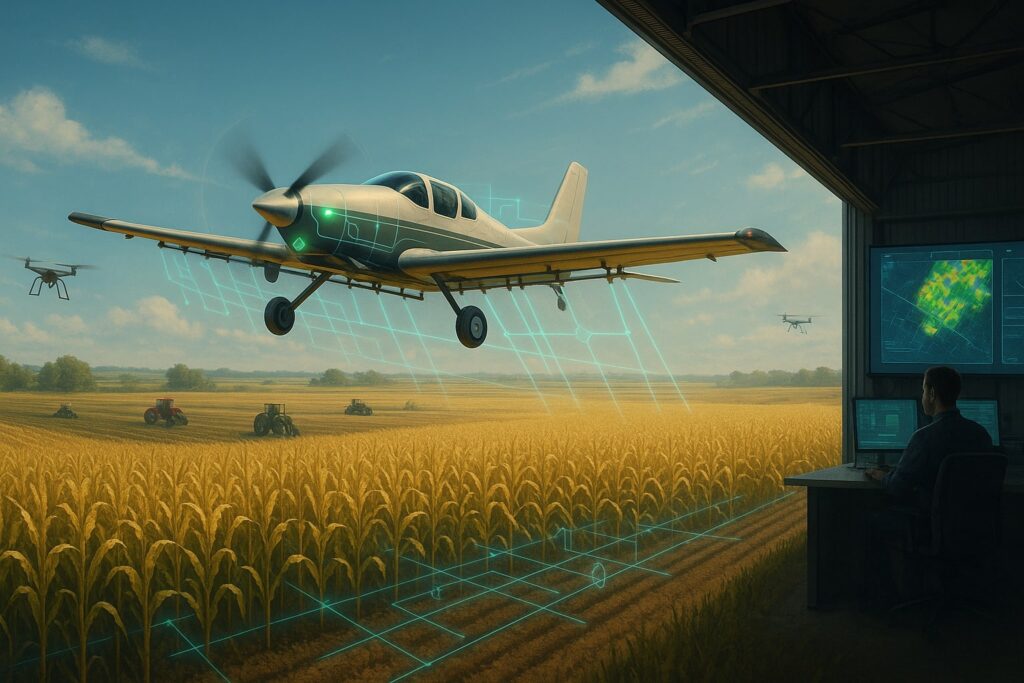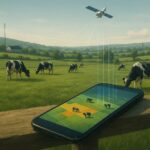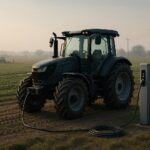China’s agricultural sector is in the midst of a high-tech transformation, exemplified by a recent large-scale aerial crop spraying initiative led by the state-owned Beidahuang Group. In Heilongjiang province, Beidahuang has deployed fleets of farm aircraft – manned planes and helicopters equipped with AI assistance – to spray crops across an astonishing 2 million hectares of farmland. This massive operation integrates fertilization, pest control, and disease prevention from above, marking a leap forward in agtech for China’s “grain barn.” The development raises a provocative question for American agriculture: Could U.S. row-crop farms leapfrog small drones and instead adopt similar AI-assisted manned aviation systems? In examining this question, we must consider cost trends, labor constraints, regulatory hurdles, and how scalable each approach really is.
Table of Contents
ToggleChina’s Aerial Spraying Leapfrog
China’s embrace of aerial crop spraying has followed two parallel tracks. On one hand, unmanned drones have become ubiquitous on smaller farms – DJI alone claims its agri-drones now spray one-third of China’s cropland. Generous subsidies and technology advances made drones a transformative tool, cutting chemical use ~30% via precision targeting and slashing labor needs as one operator manages swarms covering hundreds of hectares per day. On the other hand, for its vast state-run farms in Heilongjiang, China has scaled up manned aviation. The Beidahuang campaign uses full-size agricultural aircraft (fixed-wing planes and helicopters) to blanket huge tracts in minimal time. These aircraft are likely augmented with modern tech – GPS-guided flight paths, advanced spray controls, maybe even on-board AI for precision. The result is efficiency at scale: more than 30 million mu (roughly 5 million acres) treated in one concerted effort.
This dual-track approach plays to China’s unique mix of farm sizes. Drones excel for fragmented smallholdings; large manned sprayers excel on expansive state farms. The U.S., by contrast, has many large row-crop operations already using manned crop-dusting planes. Does China’s model suggest these U.S. farms should double down on advanced manned aircraft (potentially with AI features) rather than pivoting to fleets of small drones?
Cost Curves: Drones vs. Planes
When it comes to cost efficiency, the calculations are nuanced. Small spraying drones have plummeted in price – a typical ag drone may cost $5,000–$15,000 – and they save money by cutting chemical waste and fuel. Chinese farmers report per-hectare cost savings around 30% after switching from tractor or manned-plane spraying to drones. Maintenance and labor costs drop as well, since an electrified drone fleet needs no fuel and fewer operators. In the U.S., however, many large farms already rely on existing fleets of piloted crop-dusting aircraft. Those planes are pricey capital assets (often $100,000 up to $1–2 million each), but they cover acreage extremely fast – a single plane can spray hundreds of acres per hour, far outpacing a drone’s capacity.
Enter a new contender: AI-assisted manned systems and large autonomous helicopters. Startups like Rotor Technologies are essentially merging the two paradigms. Rotor’s Sprayhawk, for example, is an unmanned crop-dusting helicopter (based on a full-size Robinson R44 airframe) carrying a 120-gallon tank and spraying 240 acres per hour. It matches the performance of a piloted plane but needs only a two-person ground crew. The Sprayhawk’s price tag is ~$1 million – similar to a new manned ag plane – but promises lower operating costs and improved safety by removing the onboard pilot. Essentially, it’s an AI-assisted aerial system: an automated helo that can fly precision patterns, avoid obstacles via lidar, and handle terrain following autonomously.

For U.S. farms evaluating cost curves: small drones are cheap individually but you might need dozens to equal one big sprayer’s output (along with multiple batteries and employees to swap them). One large AI-guided aircraft, by contrast, has huge capacity but high upfront cost. Over time, automation could tilt economics further. Human pilots are a limiting cost factor – their training, salaries, and the risk of accidents. Replacing or aiding pilots with AI reduces those costs, albeit offset by tech investments.
Labor Constraints: A Shrinking Pilot Corps
One compelling reason the U.S. might “leapfrog” to autonomous or AI-assisted manned sprayers is the shortage of agricultural pilots. The National Agricultural Aviation Association (NAAA) reports only about 3,400 active ag pilots in the U.S., servicing 127 million acres of cropland annually. These pilots are aging and in short supply – operations are “flying as hard as ever” to meet demand, and some planes sit idle for lack of qualified pilots. Meanwhile, the job is notoriously dangerous. Flying low-altitude missions at 140 mph with a hopper of pesticide is risky business; collisions with power lines and other accidents have made crop dusting one of aviation’s most perilous jobs. Tragically, fatal crashes are not uncommon.
Drones and autonomous craft directly address these labor pain points. Drone operators can be trained relatively quickly and operate multiple units from the ground. And crucially, no human life is at risk onboard. U.S. startups like Guardian Agriculture explicitly pitch their large autonomous drones as a safer replacement for “thousands of pilots [who] climb into small planes loaded with pesticides” every season. By automating take-off, flight paths, and spraying, AI-driven aircraft could ease the strain on the limited pilot workforce.
From a labor perspective, AI-assisted manned aircraft might involve keeping a pilot in the loop (perhaps for oversight or in case of emergencies) but letting autopilot and guidance systems do most of the work. This could broaden the pool of potential pilots since less stick-and-rudder skill would be needed if the plane largely flies itself. However, even automated systems require specialized technicians and planners (for flight programming, maintenance, etc.). The upshot is that advanced automation can mitigate the current pilot bottleneck and improve safety – a significant incentive for U.S. adoption.
Regulatory Barriers and Sandboxes
Regulation will play a deciding role in how U.S. aerial application evolves. Currently, manned crop dusting is well established under FAA Part 137 rules, and thousands of manned sorties happen each year. These aircraft already employ modern tech like GPS-guided spraying and real-time meteorological sensors, so adding more AI for precision is a natural extension largely within existing rules. The FAA would likely welcome safety enhancements (for example, obstacle-sensing autopilots to reduce wire strike accidents).
Unmanned drones, however, face tighter constraints. Until recently, spraying crops beyond visual line-of-sight or at night was heavily restricted in the U.S. Progress is being made – the FAA has started streamlining approvals for agricultural drone operations. In 2025, we’re seeing more exemptions that allow larger drones to operate over farms. But it’s still a patchwork, with each UAV model needing certification and operators requiring special training and permissions. A fleet of 50 drones buzzing over a farm raises airspace coordination issues that a single piloted (or single autonomous) aircraft does not.
The concept of “AI-assisted manned” flight might dodge some regulatory hurdles. If a human pilot is officially in command (even if AI is doing the flying), the operation could be treated similarly to today’s manned flights, avoiding the need for unmanned aircraft certifications. Alternatively, optionally piloted vehicles – aircraft that can fly with or without a person on board – present an interesting regulatory middle ground that authorities are just beginning to contemplate.
In essence, U.S. regulators have to balance innovation with safety. China’s more centralized approach allowed rapid deployment of both drones and manned sprayers. The U.S. may move slower. We might see designated test programs or state-level pilots (no pun intended) where AI-guided crop dusters are trialed in a compliance sandbox. Regions facing acute labor shortages or with large, isolated farm plots (e.g. the Great Plains) could become proving grounds.
Scalability: Swarms vs. Behemoths
A key consideration is comparative scalability. Can thousands of mini-drones scale better to meet seasonal spraying peaks, or is it more scalable to field a smaller number of high-capacity aircraft? The answer may differ by context:
- Small farms and fragmented fields: Here, drones have the edge. They can be deployed flexibly to many locations at once. China’s success with millions of small farms adopting drones shows the swarm model can scale in aggregate. In the U.S., specialty crops (vineyards, orchards) and smaller acreage farms are already using drones for spot spraying and will likely expand that use.
- Expansive row-crop operations: Large corn, soybean, or wheat farms in the Midwest already routinely hire aerial applicators flying Air Tractor or Thrush airplanes. For these farms, one manned plane can cover in an hour what a drone might cover in a day. To replace that with drones, you’d need a swarm and multiple operators – which might be less efficient. AI-assisted manned systems shine here: a few automated planes could treat huge acreage quickly. They also operate in a wide weather window; high-wind conditions that might ground small drones are more manageable for a heavy aircraft.
- Continuous vs. burst demand: Crop spraying is highly seasonal. Scalability means being able to surge capacity during pest outbreaks or narrow application windows. A network of independent drone service providers can ramp up by simply adding more units/operators. A fleet of large autonomous planes is more centralized – each one is a big asset that can only be in one place at a time. The U.S. might even see a hybrid model: local drone teams for routine precision tasks, and a few big AI planes that can be rapidly redeployed to critical hotspots (analogous to how firefighting aircraft move around).
Leapfrog or Complement?
Rather than a strict either/or, the U.S. may aim to blend the best of both approaches. Drones will continue to advance – their batteries, payloads, and AI capabilities improving each year. They are democratizing aerial tech for even modest-sized farms. Meanwhile, the incumbent infrastructure of ag aviation can be upgraded: today’s ag planes already use GPS and GIS; tomorrow’s could feature full autopilot spray runs and real-time sensor feedback guiding application rates. Essentially, turning the crop duster into a smart drone with a human onboard (or back in the hanger supervising remotely).
One could envision U.S. companies and cooperatives inspired by Beidahuang’s example forming regional aerial spraying cooperatives. These co-ops might operate a few AI-assisted planes that service many farms, providing economies of scale. Farmers would get quick treatment on par with China’s state-run campaign efficiency, without each farm needing to manage a drone swarm. Such services could especially benefit areas facing labor shortages – for example, parts of the Midwest where local aerial applicator businesses can’t find enough pilots to meet demand.
Regulatory adaptation will be crucial. The FAA might create a special certification class for large autonomous crop sprayers, learning from experiments in both defense and agriculture sectors. Notably, the Pentagon has interest in unmanned helicopters and planes for logistics – technologies that often spin off into civilian use. This crossover could accelerate approvals for autonomous ag aviation.
Global Implications and Competitive Edge
The decision for U.S. agtech to leapfrog drones in favor of AI-manned systems doesn’t happen in a vacuum. Globally, agricultural productivity and sustainability are high-stakes issues. If Chinese farms achieve consistently higher yields and lower costs through these technologies, U.S. farms must keep pace to remain competitive. There’s also a geopolitical dimension: dominance in agtech could influence food security and export markets. Chinese drone companies like DJI and XAG already export their ag drones worldwide. Likewise, if the U.S. perfects AI-guided crop dusters, that know-how and equipment could become a valuable export or aid product for countries with vast farmlands (think Brazil or Ukraine).
In developing regions, leapfrogging directly to advanced aerial systems might skip the need for expensive farm machinery. For instance, parts of Africa or Latin America with large plantations but limited ground infrastructure could use a few AI-driven aircraft to cover what would otherwise need many tractors. The U.S. could spearhead that movement, creating business opportunities and soft power gains.
From an investor perspective, the race is on to capture this emerging market. There is already venture and corporate money flowing into ag drone startups and heavy-lift UAVs. The cost curve for autonomous aircraft – like any tech – should improve with scale. If the U.S. embraces AI crop dusters, it could push the cost per acre of aerial spraying even lower, further undercutting traditional methods. That in turn could change farm economics: imagine aerial application so cheap and precise that farmers use it not just for emergency pest control but for routine nutrient delivery, micro-spraying only where needed. This would be a win for both profits and environmental impact.
Conclusion
China’s deployment of mass-scale, AI-assisted manned aerial spraying is a wake-up call and an inspiration. The U.S. has the pieces in place to respond – a robust ag aviation sector, cutting-edge drone technology, and plenty of open skies over its breadbasket. The path forward may involve leapfrogging the drone-swarms-at-every-farm vision in favor of a network of smart, autonomous crop dusters servicing broad areas with unrivaled efficiency. By tackling the cost, labor, and regulatory challenges head-on, U.S. agriculture could indeed “leapfrog” into an era where AI pilots help feed the world from 500 feet above, marrying Silicon Valley ingenuity with heartland farming know-how.
Such a shift won’t happen overnight. But the next time a farming season brings a fast-moving blight or a narrow fertilization window, don’t be surprised if the solution whirring overhead is not a dozen tiny drones, but one mighty AI-guided aircraft, doing the work of many and pointing the way to agtech’s future.





